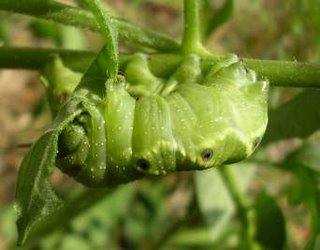
Tomatoes are great self-seeders, but in this zone, five, they almost never have enough time to produce fruit. Garden tomatoes are started inside. These particular plants did set some fruit, and early enough for it to ripen on one of them--but they were plagued by ferocious blossom-end rot: worse than I've ever seen on tomatoes we've planted. This is caused by inadequate uptake of calcium by the plant, a result of root damage, drying out too much between waterings, or an excess of one of a number of elements in the soil--any one of which could have been a factor for these unwatered plants growing in the weird mixture of rotting straw, potting soil, and some wood ash that makes up this particular waste pile.
So, these were not precious, well-nurtured plants producing food for the table. Instead, they were an opportunity. A place for tomato hornworms (Manduca quinquemaculata)! I made a plan. All summer I watched the tomatoes in the garden, and finally, on August 21, I found the stripped stems characteristic of the work of this caterpillar. A few moments search and I found the critter, quite small, about three centimetres. I plucked it off the plant (much easier to move than an almost full-size cecropia caterpillar!), and delivered it to the volunteers.

The caterpillar settled in right away and resumed eating. I checked on it daily; it was always surprisingly difficult to spot, given its size. It spent a lot of time clinging to the underside of a stem while nibbling, always nibbling the leaves. In a few days it had developed the stripes characteristic of later stages or instars of this caterpillar.

At last sighting, August 29, the caterpillar was eight centimetres long, and nice and fat. I went away for a couple of days and when I returned the caterpillar was gone. If all went well it left the plant and pupated in the leaf litter to wait until spring when it will emerge as a five-spotted hawkmoth.








2 comments:
You cannot convince me. I can never learn to love something that eats my tomatoes. :)
sean
Oh, Sean, I am sorry to hear that I haven't convinced you yet to embrace the tomato hornworm. Maybe next year...I live in hope.
Post a Comment